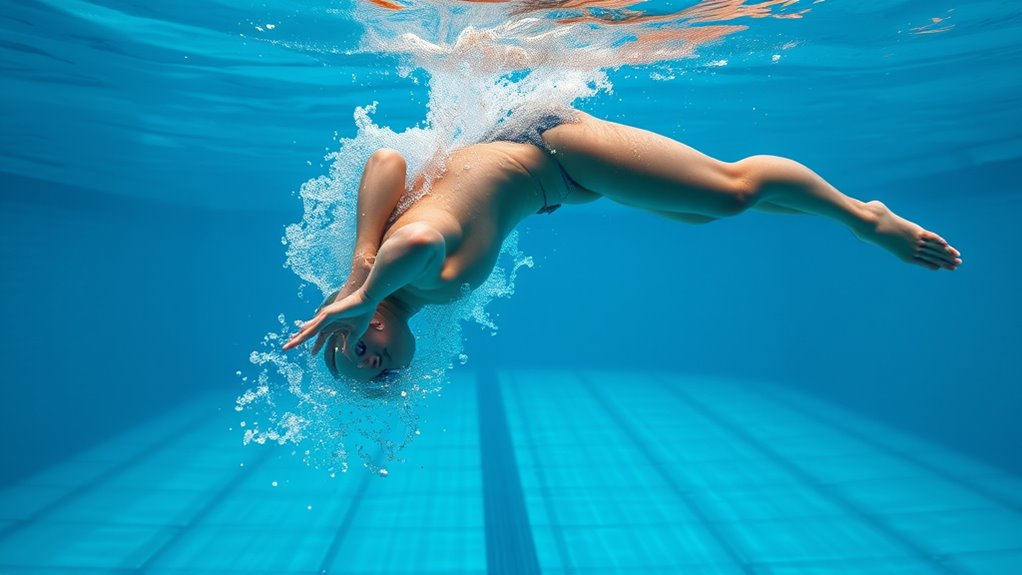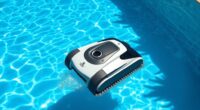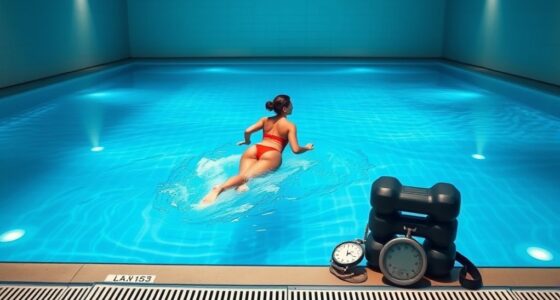Common flip turn mistakes include not approaching the wall with enough speed, poor body position during the turn, and incorrect hand placement for push-off. Overextending your push-off or hesitating before the flip can also slow you down. Many forget to use the wall effectively or neglect breathing patterns. Practicing consistently and focusing on proper technique can fix these issues. Keep exploring these tips to improve your flip turn skills even more.
Key Takeaways
- Approach the wall with enough speed to generate momentum for a smooth flip and push-off.
- Keep your body streamlined and aligned during turns to reduce drag and improve rotation.
- Ensure proper hand placement on the wall—fingers spread and palms pressed—to maximize push-off power.
- Tuck your knees tightly and roll smoothly to maintain momentum and control during flip turns.
- Practice consistently and focus on timing, body positioning, and airflow to improve turn efficiency and fluidity.
Not Approaching the Wall With Enough Speed
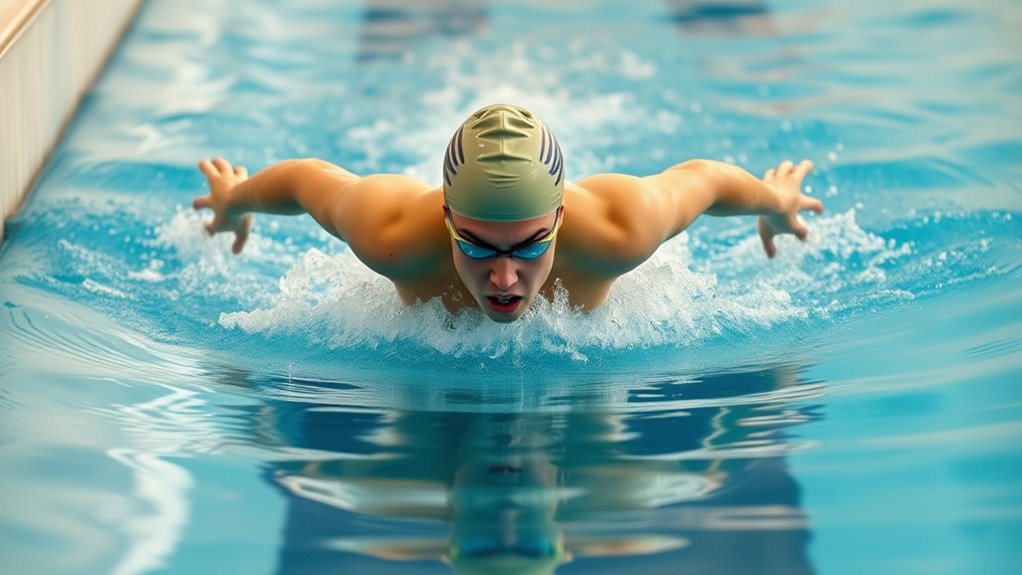
Do you ever find yourself slowing down too much before hitting the wall? This usually happens when your approach speed isn’t fast enough, which directly impacts your wall entry. If you’re too slow, you won’t have enough momentum to execute a smooth flip turn. Instead, you’ll struggle to rotate quickly and may even lose control. To fix this, focus on maintaining a strong, steady approach speed as you approach the wall. Keep your body streamlined and stay confident in your speed, so you hit the wall with enough momentum. Properly timed approach speed ensures a clean, powerful wall entry, setting you up for a seamless flip turn. Remember, a faster approach is key to maintaining rhythm and control during your turn. Additionally, understanding the importance of approach technique can help you refine your speed and efficiency in the water.
Improper Body Position During the Turn
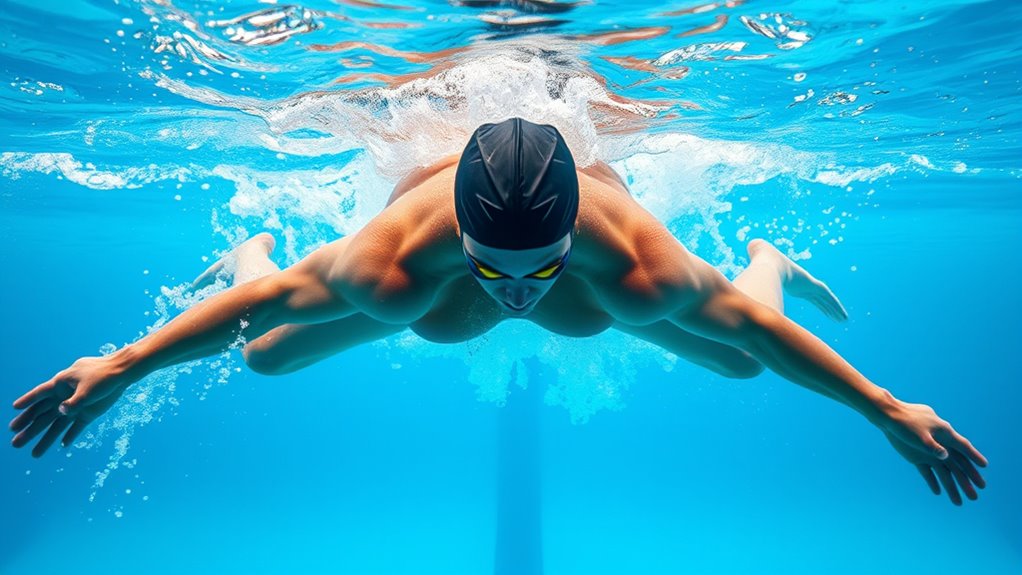
If your body isn’t aligned correctly during the turn, it can throw off your rotation and slow you down. Proper body alignment is vital for a smooth flip turn, allowing you to rotate efficiently and maintain momentum. When your core stability is weak, your body may sag or twist, disrupting the turn’s flow. Keep your body streamlined, with hips and shoulders in line as you approach the wall. Engage your core muscles to support stability throughout the flip. A well-aligned body reduces drag and helps you complete the turn quickly. Focus on maintaining a straight, tight position from your head to your toes, using your core to control your movement. Improving your body position during the turn will boost your speed and efficiency in the water. Additionally, practicing body awareness can help you identify and correct misalignments more effectively.
Incorrect Hand Placement for Push-Off
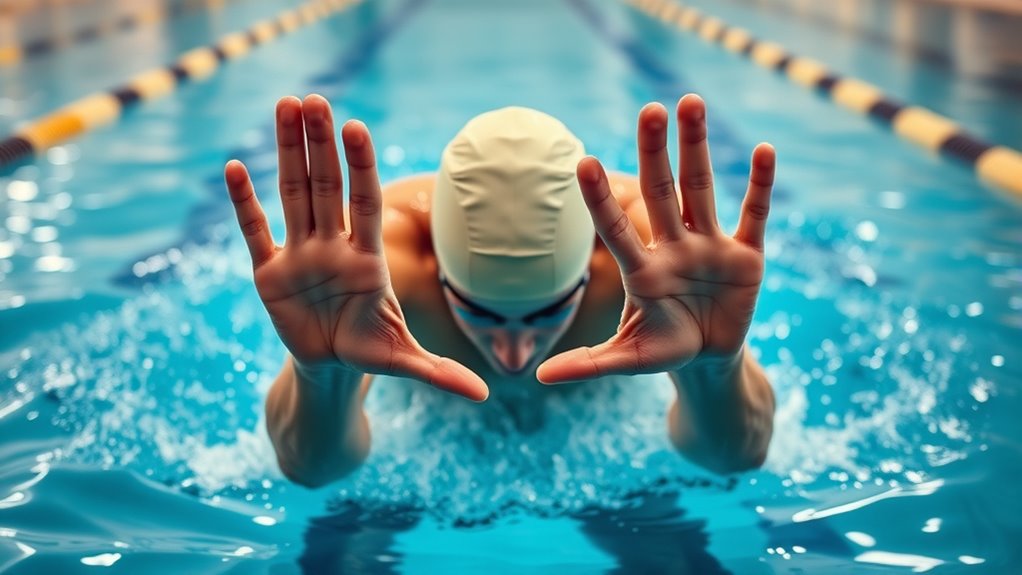
Your hand placement during the push-off is vital for a strong, streamlined finish. If your hands are positioned incorrectly, you lose momentum and speed. We’ll explore proper techniques, common mistakes, and simple tips to get it right. Ensuring proper hand placement can also improve your overall swimming efficiency, making each turn more effective and conserving energy for the next lap.
Proper Hand Positioning Techniques
Proper hand positioning during the push-off is crucial for maintaining momentum and guaranteeing a smooth flip turn. Your hand grip should be firm but not too tight, with fingers evenly spaced and pointing downward, creating a streamlined surface. Correct finger placement helps you push off with maximum power and control. Avoid spreading your fingers wide or gripping too tightly, as this can disrupt your balance and reduce push-off efficiency. Instead, keep your hands close together, with your palms pressed firmly against the wall and your fingertips aligned to create a smooth, continuous surface. This technique helps transfer your energy effectively and keeps your body aligned for a strong, fast flip turn. Consistently practicing proper hand positioning ensures you generate ideal push-off force every time. Additionally, understanding how Bitcoin IRA strategies can optimize your long-term financial growth highlights the importance of precise execution in all aspects of your training.
Common Hand Placement Mistakes
One common mistake is gripping the wall too tightly or spreading your fingers too wide, which can disrupt your balance and reduce power during push-off. Proper hand positioning and arm alignment are vital for maximizing push-off speed. If your hands are improperly placed, you may lose momentum or strain your shoulders. To avoid this, ensure your hands are placed firmly but comfortably on the wall, with fingers slightly apart to maintain control. Keep your arms aligned with your shoulders and elbows close to your body during push-off. Here’s a quick overview:
| Mistake | Correct Technique | Impact |
|---|---|---|
| Spreading fingers wide | Slightly apart, firm grip | Better balance, powerful push-off |
| Incorrect arm alignment | Arms aligned with shoulders | Increased control, reduced strain |
| Tense grip | Relaxed but firm grip | Improved flow and efficiency |
| Hands placed unevenly | Symmetrical placement | Consistent push-off force |
| Not engaging core | Engage core muscles during push-off | Enhanced stability |
Additionally, understanding technique fundamentals can help you refine your overall swimming efficiency.
Correct Hand Placement Tips
Incorrect hand placement during push-off can considerably weaken your momentum and increase strain on your shoulders. To maximize speed, focus on a proper hand grip. Place your hands firmly against the wall with fingers pointed downward, ensuring your palms are flat and shoulders are aligned. Your finger placement should be close together but relaxed, providing a secure grip without tension. When pushing off, keep your hands shoulder-width apart and press through your palms, not just your fingertips. This creates a stronger, more stable push that propels you forward efficiently. Avoid gripping too tightly or spreading your fingers wide, as both reduce power and can cause discomfort. Correct hand placement ensures a smooth, powerful push-off, boosting your flip turn performance and conserving energy for the swim. Incorporating proper hand positioning techniques can further enhance your overall push-off effectiveness.
Failing to Tuck and Roll Properly
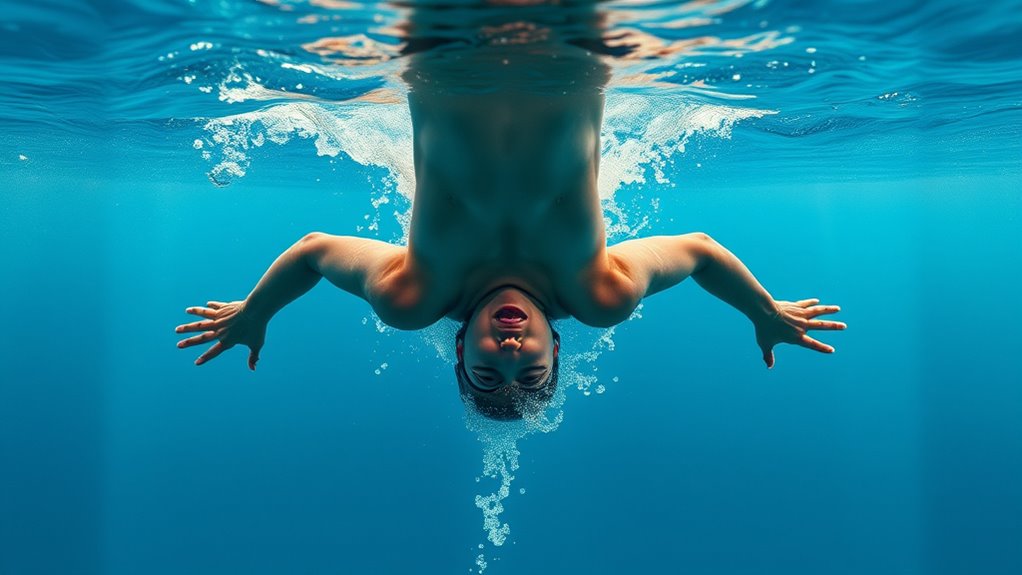
If you don’t tuck your body tightly during your flip turn, you’ll lose momentum and slow down. Make sure your knees stay close to your chest and your head stays tucked to roll smoothly. Properly rolling over helps you maintain speed and finish your turn strong. Additionally, mastering auditory cues can help you time your movements more precisely during practice.
Proper Tuck Technique
Are you failing to tuck and roll properly during flip turns? Proper tuck technique is key to a smooth, efficient flip. When you don’t tuck tightly enough, you lose streamlining and slow down. To improve, focus on these steps:
- Practice streamlining drills to build muscle memory for tight tucks.
- Time your flip turn so you tuck at the right moment, just after pushing off the wall.
- Keep your knees close to your chest and chin tucked to reduce drag.
- Use quick, controlled rolls rather than rushing, ensuring you stay compact.
- Paying attention to your body positioning can significantly improve your tuck effectiveness.
Rolling Over Smoothly
Have you ever noticed your flip turns feeling jerky or awkward? If so, you might not be rolling over smoothly. Proper body alignment is key to a seamless roll. Keep your body tight and aligned as you tuck your chin and initiate the flip. When your body is correctly aligned, it allows for better flip timing and a more controlled rotation. Failing to tuck your knees or not engaging your core can cause an uneven roll, making your turn look choppy. Focus on tucking your chin toward your chest and using your core muscles to roll over in one fluid motion. Practicing your tuck and roll repeatedly, paying attention to your body position and flip timing, helps achieve a smooth, efficient flip turn every time. Additionally, maintaining consistent airflow during your turn can contribute to a more fluid motion and prevent unnecessary resistance.
Overextending the Push-Off

Overextending the push-off during a flip turn can actually slow you down rather than propel you forward. When you push off with too much force or reach beyond the wall contact overreach, it disrupts your momentum and reduces efficiency. To avoid this, focus on controlled, powerful push-offs that stay within your body’s limits. Maintaining proper user consent management ensures you are informed about how your data is used during practice and progress tracking.
Overextending your push-off can slow you down; stay controlled and within your body’s limits for optimal speed.
Here are some tips:
- Keep your push-off compact, avoiding the tendency to overreach.
- Contact the wall at a comfortable distance, not too far from your body.
- Use your core to generate power, not just your legs.
- Practice controlled push-offs to maintain steady momentum.
Poor Streamlining After the Turn
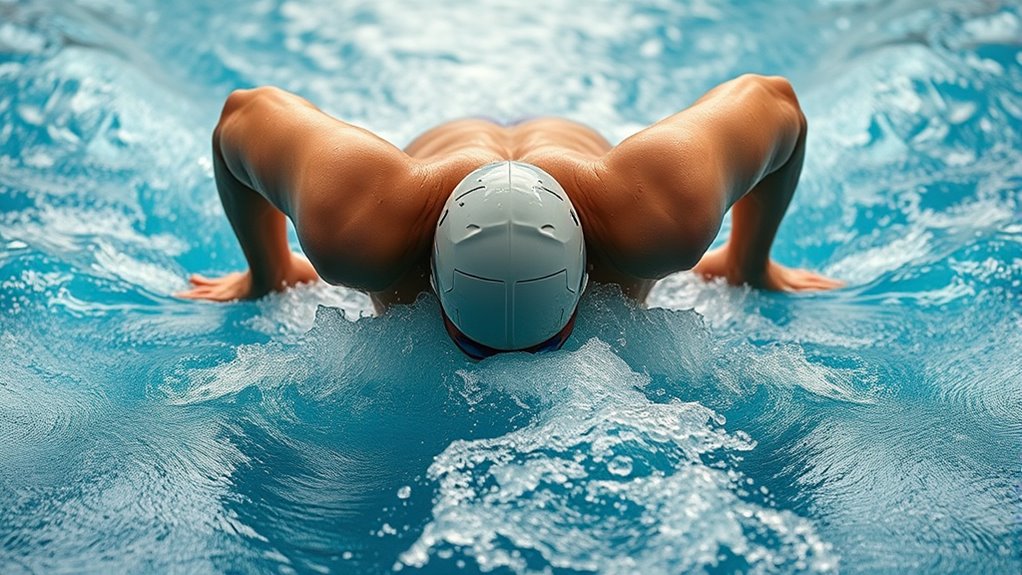
After your flip turn, make sure your body stays straight and tight to reduce drag. Use your arms and hands to streamline your position quickly, and consider equipment like fins or paddles to improve your technique. Staying efficient here can save you precious seconds on each lap.
Proper Body Position Post-Turn
When you finish your flip turn, maintaining a tight, streamlined body position is essential for minimizing drag and maximizing speed. Proper body alignment helps you glide smoothly through the water, so focus on keeping your head in line with your spine and your hips high. To improve your post-turn position, consider these tips:
- Keep your arms extended straight above your head to streamline your body.
- Engage your core to maintain body alignment and prevent sagging.
- Push off the wall with firm, pointed toes to stay tight and straight.
- Immediately rotate into a streamlined position, avoiding any unnecessary movements that cause drag.
Streamlining Equipment Use
Poor use of streamlining equipment can considerably slow you down after your flip turn. If you don’t make proper equipment adjustments, your gear selection may hinder your momentum. Make certain your goggles, cap, and swim suit are snug but comfortable, so they don’t create drag. Focus on aligning your body correctly; for example, keep your head in a neutral position and streamline your body with arms extended straight ahead. Adjust your equipment settings to minimize resistance—tighten your swim cap and choose gear designed for low drag. Small improvements in gear selection and positioning can dramatically boost your speed after the turn. Remember, streamlining isn’t just about your body—your equipment plays a key role in reducing drag and maintaining momentum.
Not Using the Walls Effectively
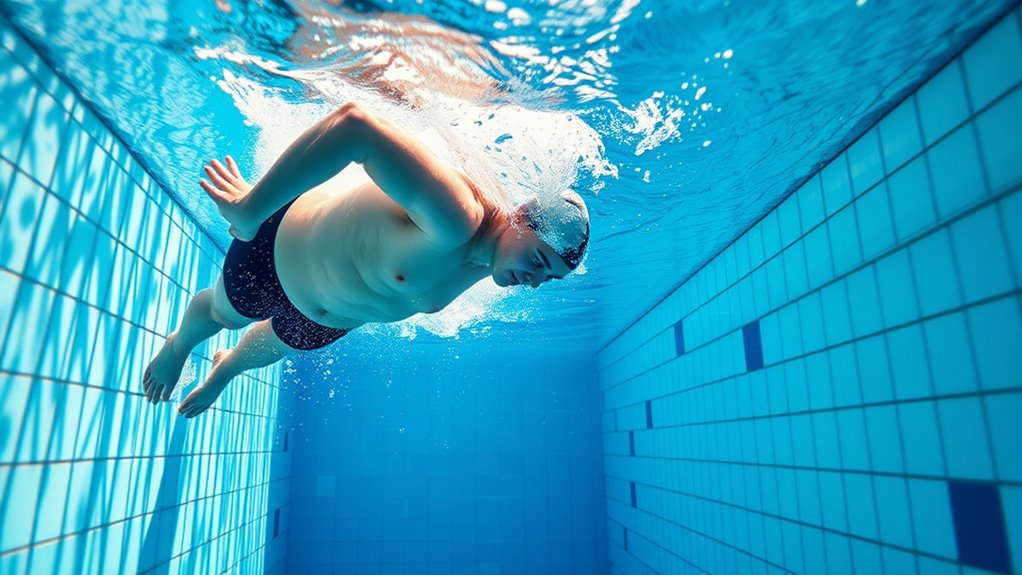
Many swimmers overlook the importance of using the walls effectively during flip turns, which can slow them down and reduce efficiency. Proper wall awareness helps you gauge the right moment to initiate your turn and maximize momentum. Focusing on turn timing ensures a smooth, fast changeover. To improve:
- Keep your eyes on the wall to stay aware of your distance and avoid rushing.
- Practice controlled push-offs by timing your turn precisely before reaching the wall.
- Engage your core during wall contact to maintain speed and streamline your body.
- Use your legs to propel yourself forward immediately after pushing off, maintaining momentum.
Ignoring the Breathing Pattern During Flip Turns
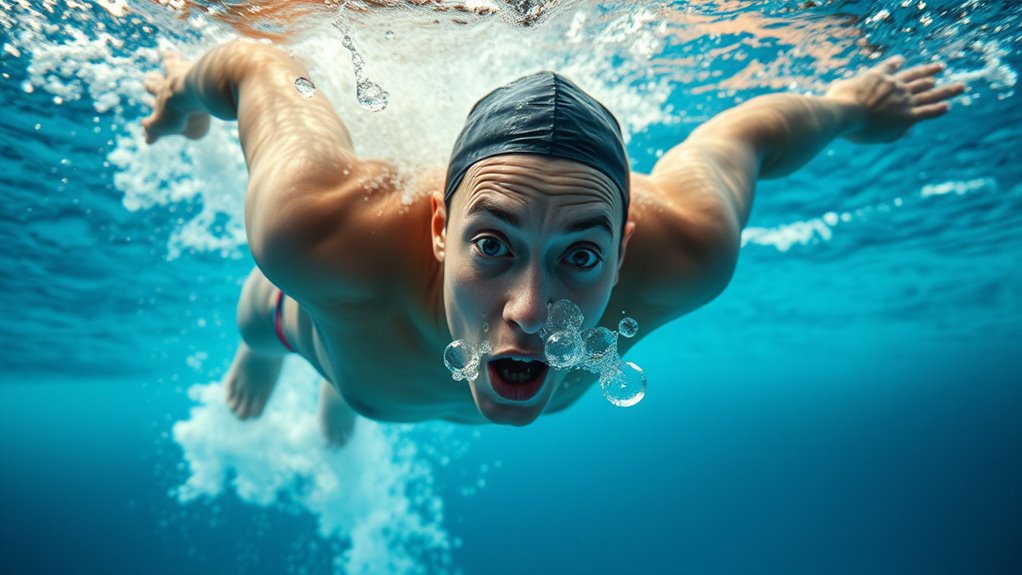
Ignoring your breathing pattern during flip turns can disrupt your rhythm and slow you down. When you neglect proper breath control, your breathing rhythm becomes inconsistent, making it harder to maintain smooth, efficient turns. Without coordinated breathing, you might find yourself holding your breath too long or gasping for air, which hampers your flow and increases fatigue. To fix this, focus on timing your breath with your turn, exhaling smoothly as you approach the wall and inhaling quickly during the push-off. Consistent breath control helps you stay relaxed and maintain momentum through the flip. Developing a steady breathing rhythm during turns ensures you conserve energy and keep your speed intact, making your flip turns more effective and less disruptive to your overall swim.
Hesitating Before Initiating the Flip
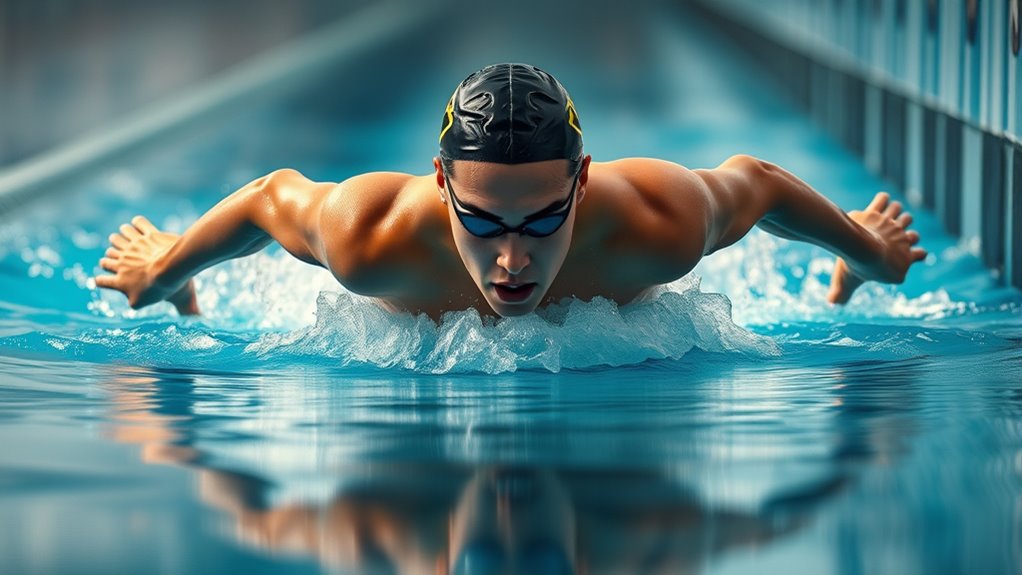
Hesitating before initiating the flip can cause you to lose valuable momentum and disrupt your rhythm. This timing hesitation leads to an initiation delay that can throw off your entire turn. To fix this, focus on these key points:
- Trust your approach speed—don’t slow down just before the turn.
- Visualize the flip early, so your mind is ready to act.
- Develop a consistent cue—like a breath or a kick—to signal when to start.
- Practice timing drills to make initiation automatic and reduce delay.
Lack of Consistent Practice and Technique Drills
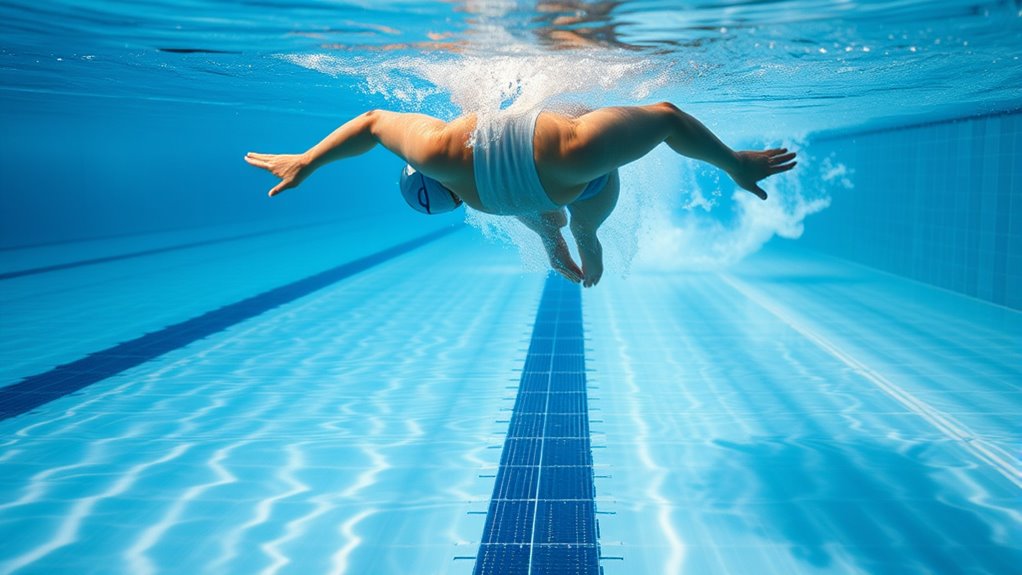
When you don’t practice flip turns regularly or incorporate specific technique drills, it becomes harder to execute the move smoothly and confidently during races. Without consistent drill practice, your technique refinement stalls, leading to hesitations or awkward turns. Developing drill consistency helps reinforce proper habits, making flip turns feel more natural over time. Focus on drills that target your weaknesses, like wall push-offs or tight rotations, to build muscle memory. Regular practice ensures you stay sharp and adapt quickly to different pool conditions. Skipping these drills can cause small mistakes to become habits, ultimately slowing your race times. Commit to a regular routine of targeted flip turn drills, and you’ll see improvements in both your confidence and overall swimming efficiency.
Frequently Asked Questions
How Can I Improve My Flip Turn Timing?
To improve your flip turn timing, focus on breath control and body positioning. Exhale steadily as you approach the wall to stay relaxed, which helps you spot the wall earlier. Keep your body aligned and streamlined, so you can initiate the flip smoothly and gain momentum. Practicing these elements will help you execute a quicker, more efficient turn, allowing you to push off stronger and maintain your pace throughout the race.
What Drills Enhance Flip Turn Consistency?
To enhance your flip turn consistency, try drill variations like the streamline push-off, somersault drills, and one-arm flip turns. Incorporate visual cues such as focusing on a fixed point on the wall or pool bottom to improve your orientation and timing. Repeating these drills regularly helps build muscle memory and confidence, making your flip turns more reliable and smoother with each practice.
How Do I Stay Relaxed During the Flip?
Imagine your body as a leaf gently floating on water; staying relaxed during your flip turn is key. Focus on steady breathing techniques to calm your nerves, and use mental visualization to picture smooth, effortless spins. When you breathe deeply and visualize success, your muscles loosen, and your mind stays centered. This calm, focused approach transforms your flip turns into graceful, flowing movements rather than frantic whirlpools.
What’s the Best Way to Practice Underwater Push-Offs?
To improve your underwater push-offs, focus on practicing proper breathing techniques and your wall approach. Before pushing off, take a deep breath and exhale slowly to stay relaxed. As you approach the wall, streamline your body and kick off with a strong, tight core. Use consistent drills to simulate the push-off, emphasizing a smooth, controlled movement, so you build momentum and maximize your underwater distance.
How Can I Prevent Hesitation Before Flipping?
Did you know swimmers often hesitate before flipping due to poor breath control? To prevent this, focus on steady breathing patterns, exhaling slowly underwater before the turn. Maintain proper body positioning—keep your body tight and aligned—to build confidence. Practice controlled breath holds and smooth body rolls to reduce hesitation. With consistent drills, you’ll feel more prepared and confident, making your flip turns seamless and faster.
Conclusion
Mastering flip turns isn’t about perfection but persistence. Every mistake is a stepping stone, a chance to improve. With focus and consistent practice, you’ll turn setbacks into breakthroughs. Remember, every splash, every push, and every turn is part of your journey. Embrace the process, and soon you’ll find yourself gliding effortlessly through the water. Because in swimming, as in life, progress flows from effort—so keep pushing, keep turning, and let your skills rise to the surface.
